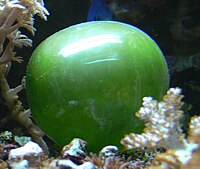
Photo from wikipedia
Addition of glucose to starved Saccharomyces cerevisiae initiates collective NADH dynamics termed glycolytic oscillations. Numerous questions remain about the extent to which single cells can oscillate, if oscillations occur in… Click to show full abstract
Addition of glucose to starved Saccharomyces cerevisiae initiates collective NADH dynamics termed glycolytic oscillations. Numerous questions remain about the extent to which single cells can oscillate, if oscillations occur in natural conditions, and potential physiological consequences of oscillations. In this paper, we report sustained glycolytic oscillations in single cells without the need for cyanide. Glucose addition to immobilized cells induced pH oscillations that could be imaged with fluorescent sensors. A population of cells had oscillations that were heterogeneous in frequency, start time, stop time, duration and amplitude. These changes in cytoplasmic pH were necessary and sufficient to drive changes in NADH. Oscillators had lower mitochondrial membrane potentials and budded more slowly than non-oscillators. We also uncovered a new type of oscillation during recovery from H2O2 challenge. Our data show that pH in S. cerevisiae changes over several time scales, and that imaging pH offers a new way to measure glycolytic oscillations on individual cells.
Journal Title: Scientific Reports
Year Published: 2017
Link to full text (if available)
Share on Social Media: Sign Up to like & get
recommendations!